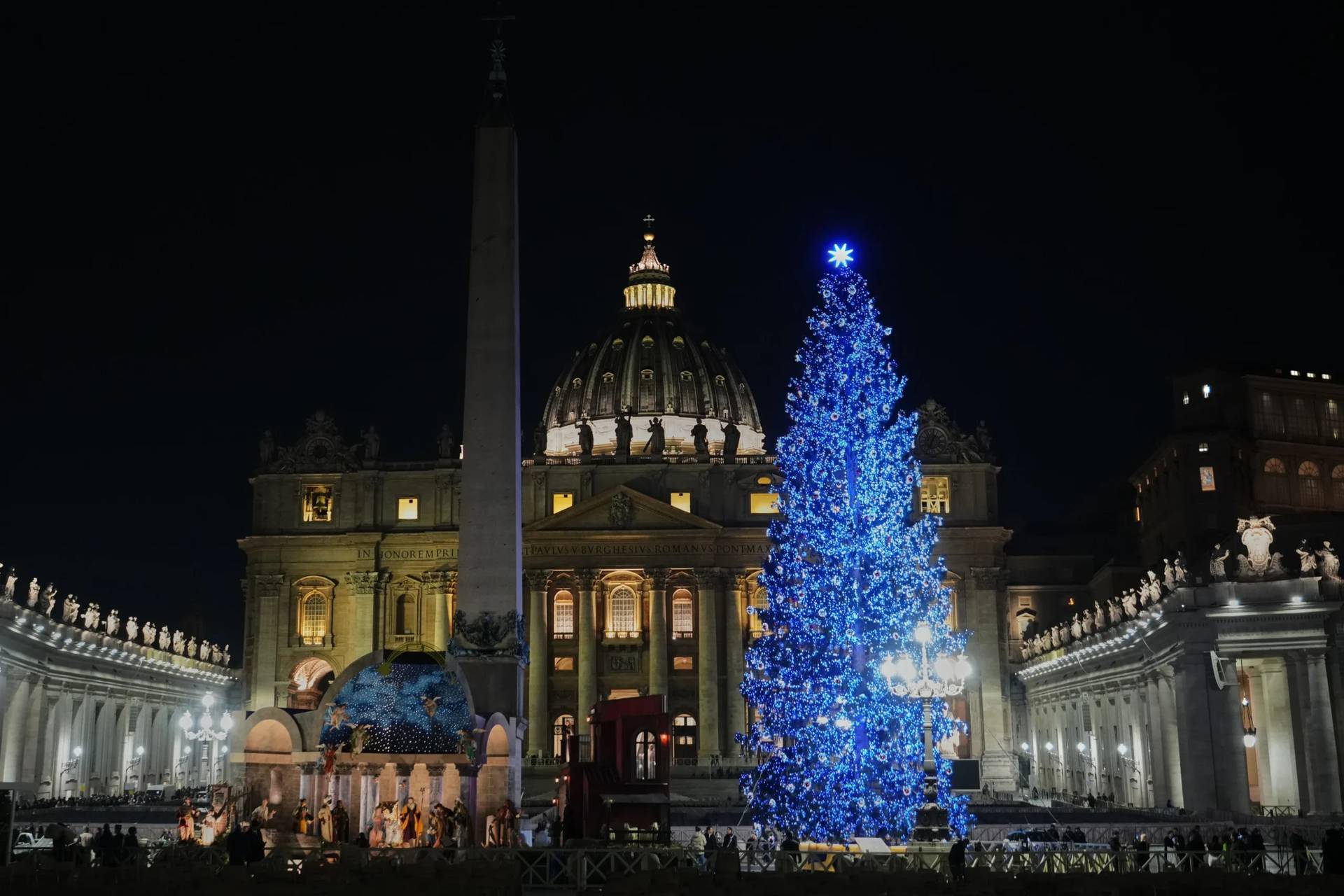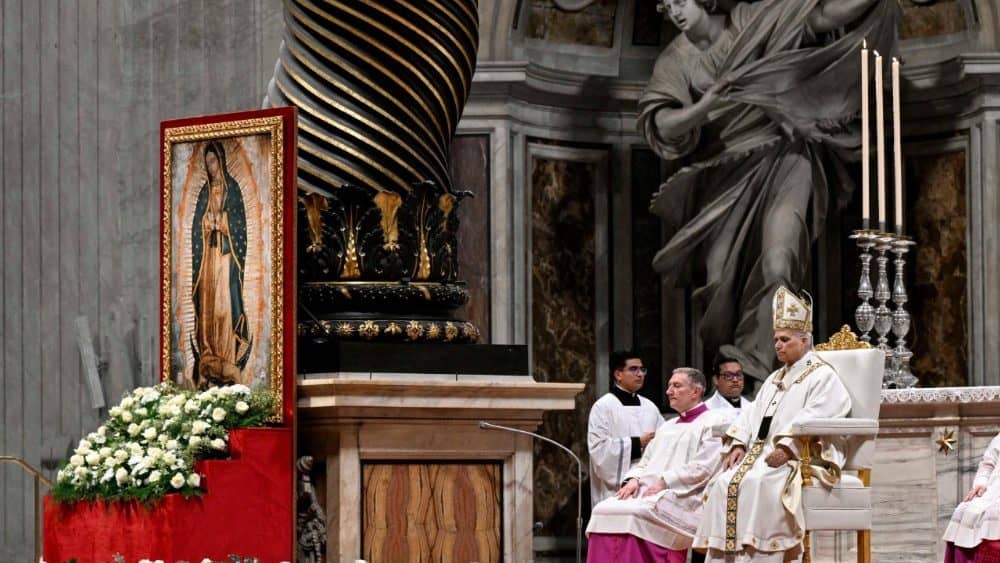ROME – Last Friday, Pope Francis took part in the inauguration of a new headquarters in Rome for Scholas Occurrentes, a high-tech network of schools around the world inspired by the pontiff. The first lady of his native Argentina, Fabiola Yañez, was on hand, as were the first ladies of Brazil, Paraguay, Colombia and Belize.
At one stage Francis and Yañez exchanged a hug of greeting, which was captured by a photographer who later discovered a curiosity in the image: On his right hip, under his white papal cassock, Francis was wearing a small black electronic device with a green light and various buttons.
On Dec. 18, Vatican spokesman Matteo Bruini told Crux the device was a rarely used radio microphone, which had to be put on the pope in that tight space because of the angles and acoustics involved.
Before that clarification, however, the Argentinian newspaper Clarín moved a Dec. 17 story speculating about what the mystery device might be, claiming to have consulted unnamed “specialists.” The article floated three increasingly alarmist hypotheses:
- A continuous infusion pump for subcutaneous insulin, part of the treatment for type one diabetes.
- A device for administering an intrathecal morphine analgesia treatment, generally used to relieve chronic pain in the spine.
- An implantable medication pump to help manage pain, with daily doses pre-programmed.
Clarín did allow for other possibilities, but in the same breath essentially dismissed them: “Outside these hypotheses,” the article said, “it could be a security or communication device, but everything indicates that it is one of the three used by modern medicine.”
“Everything,” apparently, short of asking somebody who might know.
I wasn’t privy to the editorial process behind the piece, but it’s hard not to suspect that nobody bothered trying to find out what the “black box” actually was because it might have scuttled a juicy little story about a potential papal health scare, and, to boot, one that ran on the day Francis turned 83.
It’s a reminder of an infallible law of life on the Vatican beat: The older a pope gets, the more often there will be headlines about possible health problems.
(When St. John Paul II died in 2005 close to his 85th birthday, the running joke in press circles – and, to be honest, it actually wasn’t that much of a joke – was that all his obituaries had been written years before, in some cases by journalists confident the pope was on death’s door back then, who had themselves gone to their reward well before the pope actually did.)
There are two observations worth making in light of this week’s basic non-event.
First, one of the attractions of papal health scares is that they legitimize open speculation about the next pope.
Papal politics are different from secular systems, and especially the American one. In the United States, talk about who the next president might be generally begins the day after the current one is elected, and builds steadily in intensity for four years until reaching a crescendo with the next election.
In the papal system, however, open conversation about successors is considered taboo as long as the current pope is still around. That’s not to say such talk doesn’t happen, but you’re not going to catch cardinals on the Sunday morning news shows talking about the horserace to succeed Francis. It’s done sotto voce, behind closed doors, and with the utmost discretion.
(Some pious Catholics find any talk about papal politics offensive, on the grounds that it discounts the role of the Holy Spirit and divine providence. The rebuttal comes from no less an authority than Pope Benedict XVI, who once said it’s a mistake to believe the Holy Spirit supplants human judgment in the process – the proof, he said, is that there are simply too many popes “the Holy Spirit obviously would not have picked.”)
The media is ever alert to opportunities to force the underground conversation about papal succession into public view, and the older a pope gets, the more such opportunities seem to present themselves. These days, that’s not only because age might betoken health issues, but also because retirement is an increasingly live option as time goes on.
Second, the black box non-story ought to be a wake-up call for Vatican commentators and pundits everywhere, because it invites the question: Are we ready?
Suppose this really had been a medical device, signaling a hidden malady that could mean the end is near. Instantly the entire world would want to hear about the possibilities for what comes next, and it’s not clear we’re ready to respond.
Some time back, for example, a smart bishop asked me who the center-right cardinals, meaning ones who want to maintain the best of the Francis papacy but with a slightly more traditional cast, are looking at as possible popes. Speaking for myself, I had precious little idea then, and I still don’t.
(It’s probably slightly easier to tick off a few names who might fit the bill for cardinals seeking for continuity in the next pope rather than a course correction, but even that’s a bit dicey.)
This week, therefore, is a reminder that we need to be thinking about what comes next, not out of any desire to truncate Francis’s term, or any reason to believe the pope is weakening, but simply because it matters so deeply … and because, sooner or later, one of these scares will be for real.
Follow John Allen on Twitter: @JohnLAllenJr
Crux is dedicated to smart, wired and independent reporting on the Vatican and worldwide Catholic Church. That kind of reporting doesn’t come cheap, and we need your support. You can help Crux by giving a small amount monthly, or with a onetime gift. Please remember, Crux is a for-profit organization, so contributions are not tax-deductible.













